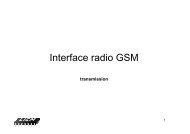Dependable Memory - Laboratoire Interface Capteurs ...
Dependable Memory - Laboratoire Interface Capteurs ...
Dependable Memory - Laboratoire Interface Capteurs ...
You also want an ePaper? Increase the reach of your titles
YUMPU automatically turns print PDFs into web optimized ePapers that Google loves.
2.1. ERROR DETECTION 37<br />
a new data symbol which cannot be uniquely expressed as the combination of inputs [FP02, Nic02].<br />
In other words, they are useful in checking arithmetic operations, where parity would not be pre-<br />
served [FP02, IK03]. The information parts of an operand are processed through a typical arithmetic<br />
operator, while a check symbol is concurrently generated (based on the information bits) [Bic10].<br />
They have two classical implementation: AN and residue codes.<br />
AN codes are the simplest form of arithmetic codes [Muk08]. They are formed by multiplying<br />
each data word ‘N’ by a constant ‘A’. The following equation gives an example of an AN code:<br />
A (N1 + N2) = A (N1) + A (N2) (2.1)<br />
They are preserved only under arithmetic operations and they are not valid for logical and shift<br />
operations. They are not commonly employ due to their high hardware and timing penalty.<br />
Figure 2.8: Residue codes adder [FFMR09].<br />
Residue codes are another type of arithmetic code, in which the information to be used in checking<br />
is called the residue. The residue, r, of an operand, A, is equal to the remainder of ‘A’ divided by the<br />
modulo-base ‘m’ [Bic10]. Both the computations occur simultaneously (see figure 2.8). For the first<br />
computation step, two operands, A and B, undergo an arithmetic operation in the ALU. A residue<br />
generator then produces a residue code from the ALU result. For the computation, each operand<br />
concurrently enters a residue generator. These residues then undergo the same ALU operation as in<br />
the first computation (addition in this case) [FFMR09]. Finally the residue is compared to find the<br />
errors.



